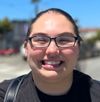All Proposed Slow Streets Rejected For Greater Ingleside, Parkside Neighborhoods
After collecting feedback from residents, the San Francisco Municipal Transportation Agency determined it will not install any Slow Streets in the greater Ingleside or Parkside neighborhoods.

The greater Ingleside neighborhood won’t be part of the Slow Streets program any time soon, recommendations made by the San Francisco Municipal Transportation Agency released last Friday show.
Slow Streets is part of a program designed to give residents more space to socially distance from others to exercise, bike and walk along the street. The roadway is temporarily closed off to most thru traffic, but private vehicles can still enter the street if the final destination is the vicinity of the area.
Back when the SFMTA initially began the program in April, a portion of Holloway Avenue was considered for the first phase, but was eventually dropped after the San Francisco Fire Department said the roadway was needed for emergency vehicle access.
Now, in its fourth phase, several streets in or near Ingleside were included as proposals in November for the fourth phase, but we’re all shut out from becoming a Slow Street due to the lack of support from those who took a survey from the SFMTA.
Last Friday, the transit agency released its initial survey findings and recommendations for the proposals that the SFMTA had grouped as Oceanview/Parkside. None of seven proposed Slow Streets received “Strong Support” based on feedback from the community.
A total 228 people responded to the survey specifically about the Oceanview/Parkside Slow Streets proposals. Only 28% of respondents said they supported expanding the program into the neighborhood.
Of the proposed seven streets, three had received the most support: Byxbee Street from Holloway Avenue to Randolph Street, De Montfort Avenue from Ashton to Miramar avenues and Farallones Street from Orizaba to San Jose avenues.
Other streets considered for the program included Ocean Avenue from Country Club Drive to 19th Avenue, Eucalyptus Drive from Clearfield Drive to 20th Avenue (alternative to Ocean Avenue), Montana Street from Orizaba Avenue to Summit Street (alternative to Farallones Street) and Granada Avenue from Ocean to Lakeview avenues.
Dan Weaver, the executive director of the Ocean Avenue Association, said in an email to the SFMTA that he was surprised by the decision to include any of the proposals in the fourth phase of the program.
“If you require strong support you should organize neighborhood meetings and explain the value of Slow Streets,” Weaver wrote.
Zack Subin, who lives near the intersection of San Jose and Lakeview avenues, said it was disheartening to learn there would be no Slow Streets in the area. He said he would have liked to see the proposal of Farallones Street from Orizaba to San Jose avenues.
Subin was also surprised to see other areas in the city that were part of the next phase received overwhelming support from those communities.
“We have a longer way to go than I thought and maybe my view of what I would like to see actually happen is the minority,” subin said.
Subin added that the transit agency does not necessarily have to follow Slow Streets approach, but can also do meaningful traffic calming improvements to slow drivers down where pedestrians and cyclists feel unsafe.
Jodie Medeiros, executive director of advocacy organization Walk San Francisco, said Slow Streets need not take a “cookie-cutter approach” given the uniqueness of each street and neighborhood, citing the Tenderloin as an example.
“The city worked with the neighbors to get extended walking space on Jones Street because that was what they wanted and needed,” Medeiros said. “It took months of planning, and multiple city-agency coordination, but it showed that it can be done if this is what the neighbors desire.”
The SFMTA has installed 25 Slow Streets to date.
“I do not feel that soliciting the views of just over 200 people is adequate outreach to determine whether the Ingleside should have Slow Streets,” SFMTA Citizens’ Advisory Committee member Neil Ballard said. “I’d like to see multilingual posters advertising the online survey as I’ve seen in other neighborhoods.”
Besides the Oceanview/Parkside area, the transit agency sought input from residents on putting Slow Streets in the Bayview, Inner Sunset, Outer Mission, South of Market, Visitacion Valley and Western Addition for phase four of the program. Those survey results can be found on its website.
Support independent community news
No media outlet covers our neighborhood like The Ingleside Light. Full stop.
Reader support sustains the expensive reporting our community needs and deserves. Will you join the hundreds of readers and become a member?







